You usually need a lot of dust to build some of the more complex or fun decks in Hearthstone. Unique effects are typically reserved for Legendary or Epic cards, and they often need support from other Legendary or Epic cards to function, so a typical day in Hearthstone on a budget means playing aggro or some kind of a midrange deck with at most a Witch's Cauldron thrown in for some surprises. This can all be fun and good, but what if you yearn for more?
I have some good news and some bad news for you. The good news is that viable combo decks can be built for under 4000 dust – far below the 10,000+ that many of them have traditionally cost. The bad news is that it is not possible to build a viable combo deck without Epics or a Legendary. I have worked on them for a while now, and I don’t think it can be done in the current meta.
In this article, I will take a look at what can be done on a relatively small budget. In particular, I will examine three decks: OTK DK Paladin (3000 dust), Inner Fire Combo Priest (2280 dust), and Mecha’thun Druid (3440 dust). All of them are capable decks, especially the Mecha’thun Druid, and they bring a different playstyle to within the reach of a regular Hearthstone player.
Budget OTK DK Paladin
I have often been asked to build budget control decks. Unfortunately, the task seems impossible, because for some reason just about every board clear or removal spell is an Epic. Shield Slam. Reckless Flurry. Brawl. Dragon's Fury. Meteor. Epic, epic, epic.
However, there is one class that is an exception to this. The removal spells that Paladin uses are Rares, not Epics! Equality, Shrink Ray, Wild Pyromancer!
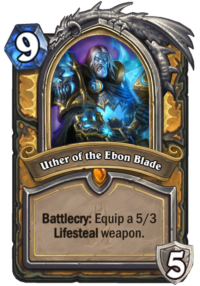
So, Paladin looks promising, because one of the things a control deck has to be able to do is remove threats, and with Paladin, you can do so on a budget. However, you also need a win condition. In the current meta, removing a bunch of things and waiting is not a viable gameplan. Uh oh, it seems that Paladin’s threats are all – Legendary! Building a Control Paladin without a number of Legendary cards is a difficult task.
The natural next question is, what is the cheapest win condition you can put in a Control Paladin shell? The answer is Uther of the Ebon Blade. Yes, it is a Legendary card, but it gives you a clear win condition – the four Horsemen OTK combo – and you can build that win condition with support cards that are mere commons: Youthful Brewmaster, Ancient Brewmaster, and Blackwald Pixie. These tools allow you to bounce Horsemen to the safety of your hand until you can play all four Horsemen on the board in a single turn and win the game.
Note that all four Horsemen have unique names, and you need one of each for the combo: your Hero Power will never roll a duplicate of a Horseman on the board, but it can and will roll duplicates of ones in your hand. You need to get three Horsemen to your hand – the fourth can be rolled from Hero Power – so the first one is 100% guaranteed to be unique, the second roll is 75%, and the third roll is 50%. Overall, you have a 37.5% chance to roll a unique Horseman on the first try on each of your attempts.
That, in a nutshell, is the story of this Budget OTK DK Paladin deck. It is a control deck at heart – and the most affordable control deck you can build at that – that just happens to have a combo finisher, because it cannot afford any other finisher. It is a deck that can fight against aggro decks in true control fashion, running them out of resources and standing tall behind a defensive perimeter of Spikeridged Steeds. Yet, it also has a chance against slower decks, because it has a valid, even if a bit slow, win condition for those matchups in the Horsemen OTK.
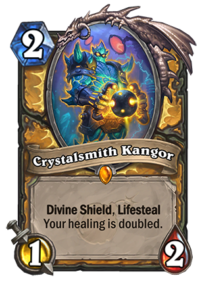
It makes sacrifices, because it’s a budget deck. It does not have Bloodmage Thalnos and Crystalsmith Kangor, so it cannot make good use of Crystology for card draw. It cannot afford Call to Arms, because then it cannot even do the OTK anymore, given that Youthful Brewmaster is a key piece as the deck does not have Zola the Gorgon. There is no Shirvallah, the Tiger here, no Holy Wrath combo – which could be an alternative, but it also requires Baleful Banker, and it is at its best in a hybrid build that runs Uther as well, so it is more of an improvement to this deck than an independent starting point.
You need to be more careful about your health when playing the budget list than when playing a full-cost version. You simply cannot heal from near-death to full in a single turn with some Kangor and Shirvallah plays. This affects how greedy you can be with your board clears, and makes you weaker. Well, it is a budget deck after all.
You have some surprises up your sleeve though. With four Brewmasters in the deck, you can find your combo relatively fast, as long as you manage to draw Uther of the Ebon Blade. If you’re on the Coin, you want to hold onto it in slow matchups, because you also have the Blackwald Pixie: with the Coin, it is enough to bounce two Horsemen to your hand, and then play those, Hero Power, play Pixie, play Coin, and Hero Power again for the OTK. This surprise element can help you against other combo decks, as it is not very common in the archetype right now.
It is also possible to upgrade the deck into a Wrath OTK Paladin, for example along the following path:
- Shrink Ray -> Shirvallah, the Tiger: Adding in some extra healing is a key part of upgrading the deck.
- Ancient Brewmaster -> Baleful Banker, Hammer of Wrath -> Holy Wrath: This gives you the first Holy Wrath combo. Now you can choose to go for the Horsemen OTK or for Holy Wrath during each game.
- Blackwald Pixie -> Crystalsmith Kangor: More healing, preparing to improve card draw.
- Hammer of Wrath -> Bloodmage Thalnos, 2 x Spikeridged Steed -> 2 x Crystology, 2 x Loot Hoarder -> 2 x Novice Engineer: The Crystology-based card draw package is now complete.
- Ancient Brewmaster -> Zola the Gorgon: Zola is the best bounce card and greatly improves the deck.
- Truesilver Champion -> Prismatic Lens
- Potion of Heroism -> Prismatic Lens: Final card draw improvements.
Budget Inner Fire Combo Priest
There can hardly be a more iconic combo than Divine Spirit and Inner Fire. Making a huge minion that can one-shot the opponent is part of Priest’s class identity, these are Classic and Basic cards we are talking about.
But can such old cards compete in the current meta? As it turns out, yes, they can. I tried for quite some time to build a really cheap budget combo deck around these cards, but in the end that was unsuccessful. You need a pair of Epic cards for the deck to be good enough: Shadow Visions is a mandatory inclusion. The consistency and additional power from multiple Divine Spirits is simply needed in the current meta, the deck is not competitive without Shadow Visions. With two copies of Shadow Visions, however, it is perfectly playable, even in Legend.
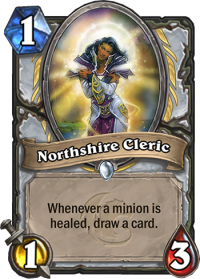
You start the game by looking for some card draw, and casually drop a Northshire Cleric or an Acolyte of Pain on the board. If you continue with a Tar Creeper, you can still bluff being Mind Blast Priest, but if you instead go for some Extra Arms to gain board control, the opponent will start to realize what’s coming. That does not mean that they can stop it though, as Tar Creeper, Injured Blademaster, and Witchwood Grizzly provide the deck with a number of high-health minions that can also be brought back from the dead with Eternal Servitude.
This deck is a pure combo deck, there is no hint of control here. You will not be able to outlast the opponent, you need to beat them down. Drawing and then drawing some more is the key, and the deck uses age-old Priest tools to do so, including combos with Wild Pyromancer, Northshire Cleric, and Circle of Healing.
In this budget build, I have chosen to include two copies of Silence and no Mass Dispel. This makes the deck a little faster, as you can push through a taunt minion without spending any mana, but you cannot push through multiple taunt minions in the late game. Given the limited late-game capabilities of the budget build, I consider this an acceptable choice.
The main weakness of Inner Fire Combo Priest is Hunter. It is hard to take this deck and try to beat cards such as Hunter's Mark and Freezing Trap. It is hard to get multiple minions to stick on the board, and a single minion has a hard time reaching the Hunter’s face. Therefore, the deck is quite meta-dependent. You can use it to fight Clone Priests and other combo decks, and you have some tools to clear token boards, but the deck does not have a wide toolkit.
There are some full-cost lists built around the same core that run Lyra the Sunshard for some extra random surprises, but overall they share the same strengths and weaknesses as the budget build. There are also Divine Spirit lists built with a dragon core, and those have some more removal tools thanks to Duskbreaker and Primordial Drake. That is a promising direction, should you want to stick with the archetype, but as the entire core changes to dragons, there is no simple upgrade path to those: the dragon package needs to be included in one go.
Budget Mecha’thun Druid
At 3440 dust, this deck is the most expensive of the three, but it is also the most capable. It is not really a budget build at all, because Meati’s Mecha’thun Druid list is only one card different, running a second copy of Branching Paths instead of the Oaken Summons in this build. That change would increase the cost of the deck by another 360 dust, but it would also make it slightly better. For this article, however, I tested the cheapest possible variant, and can attest that it is already a perfectly capable deck.
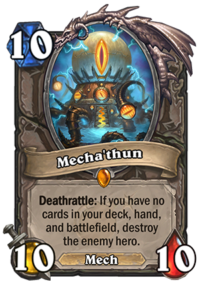
Mecha’thun Druid’s game-ending combo is to draw the entire deck and play all cards except for Mecha'thun, Innervate, and Naturalize in such a way that it has no minions left on the board. This results in a final turn where Mecha'thun dies on the board with the deck, board, and hand empty, and thereby wins the game.
Mecha’thun Druid is a very fast combo deck. It can cycle through the entire deck rapidly and has a number of removal tools at its disposal, especially Wild Pyromancer + Barkskin together with several cheap spells and an Acolyte of Pain for some card draw while at it. Because the deck can use one Naturalize for removal and easily armor up to buff Lesser Jasper Spellstone, it has some capabilities to remove big minions as well.
The deck is, however, extremely difficult to play. You will have multiple rapid cycle turns with the aforementioned Wild Pyromancer and Acolyte of Pain combo or with Gadgetzan Auctioneer, and you need to keep track of your remaining cards throughout these intense turns. There are several minions in the deck and there are several spells in the deck that can only target minions, and you need to get rid of them all before you can do your combo. You can lose to a control deck in fatigue, if you end up with an unplayable card in hand or an extra minion on the board that you cannot remove.
If that is not complicated enough, the opponent may pull some tricks on you as well, for example by giving you some extra minions with Psychic Scream or with a simple Saronite Taskmaster. In order to respond to such threats, you can hold on to an extra Innervate or Biology Project and a buffed up Lesser Jasper Spellstone for your combo turn, as you can burn those into your Mecha'thun if they are not needed for other purposes.
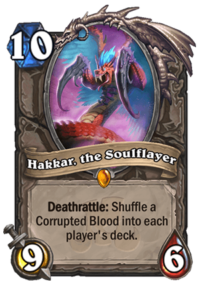
It is not common for Hearthstone decks to be difficult to play. Most combo decks are not really difficult to play. Sure, many decks require some practice, but the difficulty level of Mecha’thun Druid is perhaps unparalleled in the history of the game. At the very least, it is right up there with the most difficult decks. Something like Mecha’thun Warlock or Hakkar Druid are clearly easier decks, even though they also require careful navigation.
However, there is a reward for those who want to work on the deck enough. A full-powered combo deck for less than 4000 dust, even assuming you will want to switch in the second Branching Paths if you really want to keep playing the archetype. Your combo dreams are only some practice away.
You can also easily turn Mecha’thun Druid into Hakkar Druid. It is even more powerful and also slightly easier to play, as you do not have to worry about playing every card and removing all of your own minions:
- Oaken Summons -> Branching Paths: The upgrade you want to make for the Mecha’thun list anyway when you can afford it.
- Oaken Summons & Mecha'thun -> King Togwaggle & Hakkar, the Soulflayer: There you go, win condition has been changed. Now you can start killing people with Corrupted Bloods or sometimes just steal their deck.
Semi-budget combo decks are possible!
I have not been able to find or build any combo decks that would be really cheap, under the cost of a single Legendary card. Something like that would be a real budget deck from my perspective. However, it is possible to combo people down for less than 3000 dust, and it is possible to combo people down even in high Legend for less than 4000 dust. If you’re looking for a change of pace from aggro and midrange decks, dust does not have to stop you.
What about you? Have you played any other somewhat cheap combo decks? Let me know in the comments!













































[…] Article: How cheap is your combo? Budget combo decks in Hearthstone’s Rastakhan’s Rumble […]
Should I craft Even Warlock or Mecha’thun Druid?
With the new nerfs coming on Tuesday, nobody knows what the meta will look like. I would wait a week or two before crafting anything.
I want to ask that i will have enough dust to craft 1 legendary, should i craft uther or mecha’tun. uther deck is almost complete, being uther is one last card in that deck, while mechatun deck still need a lot of card, or should i craft shivallah right now and upgrade it later
If you’re that tight on dust, it’s a tough call. Uther rotates out in April, Mecha’thun does not.
We do not know what the post-rotation decks will look like: can Shirvallah, Baleful Banker, and Holy Wrath still work even without Uther? Can Mecha’thun Druid survive without Barkskin (key card for Pyromancer combos)? Both concepts have their combo intact, but may not have the support cards for a good deck.
It depends on what you like to play. If you have the other pieces to build a Holy Wrath deck with Shirvallah and without Uther, you can try that, but it is weak against some of the meta. Mecha’thun is stronger, but even its prospects in the post-rotation meta are not certain.
thank you, that help me a lot with my decision